Top
10 Internet Scams for 2003
It's the stuff of love-hate relationships:
Online auction sites continue to be wildly popular places to buy and
sell things -- but they also rank No. 1 for Internet-related fraud
complaints.
Online auction fraud has topped the National Consumer
League's list of Top 10 Net Frauds for five straight years through
2002, and the latest NCL starts from the first half of this year seem
certain to make 2003 the sixth year.
Most bidders filing auction-related complaints said
their problem was that merchandise was either misrepresented or never
delivered, according to the league. Those same problems are also behind
the majority of general online shopping complaints, which came in
at No. 2 on the league's list.
You
don't have to join the ranks of the defrauded masses, though. There
are ways to protect yourself no matter where you're shopping: using
a third-party escrow service when shopping at auctions and paying
with a credit card, take a look at the rest of these common consumer
pitfalls.
Nigerian money, adult Web sites
At
No. 3, Nigerian money offers -- the scam that just won't die -- follows
auctions and general shopping complaints on the NCL list. If you're
one of the lucky few to have somehow missed this one, it usually comes
in the form of a plea for help, often from a supposed civil servant
in Nigeria who is purportedly trying to get money out of the country.
But it can come from other countries as well, including Zimbabwe,
the Ivory Coast and Sierra Leone. The latest tactic for luring victims,
reported Oct. 3 by Reuters, is to make the e-mail look like it was
sent from a real London bank. In the past, these scammers also have
used fake Web sites to bait people. In exchange for the use of their
bank account, the recipient is told they'll receive a percentage of
the funds being moved. Sound farfetched? Unfortunately, a good 10%
of all recipients seek further contact with the authors and 1 percent
of those respondents become seriously involved, according to the Middle
Atlantic-Great Lakes Organised Crime Law Enforcement Network.
The real trap is sprung when victims are told the
deal is in jeopardy unless they can come up with cash to cover unexpected
fees or bribes. These first requests are followed by more and more
requests for money, drawing out the scam as long as the victims are
willing.
Internet-access frauds appear at No. 4. Most Internet-access
complaints are generated when a consumer's service is changed without
his permission. No. 5 on the list is the information/adult services
scam. That's the one where people are lured to adult sites where they
can supposedly download free pictures, only to have their Net connection
re-routed through a long-distance connection (across the globe, not
just across the country). The victim doesn't feel any pain -- until
the monstrous long-distance bill arrives.
Where
the offers come from:
This year, fewer people who filed Net fraud complaints -- only 3 percent
of them -- said they were lured with e-mail. That may be because the
deluge of spam world-wide may have made some consumers more sceptical
of e-mail offers. A year ago, 8 percent of the complaints cited e-mail,
and in 2001, 15 percent.
A full 97 percent of victims found trouble on their own through general
Web browsing and shopping, and a small sliver -- 0.1 percent -- were
targeted in newsgroups.
What
you can do
If you're still unaccustomed to hitting that Delete key, a good way
to screen many of the questionable promotions in your e-mail inbox
is to stop by one of the sites that specialise in debunking bogus
e-mail. Snopes.com is an excellent site for screening out the junk
-- those that pull on your heart as well as your purse strings.
For safer online shopping, the FTC recommends following
the five tips below. If you're shopping at auctions, the NCL and FTC
also suggest using escrow services, such as Escrow.com. These are
third parties that hold the buyer's payment until the goods arrive.
Using an escrow service, however, is especially important if you're
not paying with a credit card. Be wary, however, of escrow services
that do not provide a phone number or physical address. Without the
address, the NCL says, you have no way of checking with state authorities
to determine if the service is licensed. Fake escrow services do exist
and will simply disappear with your money.
The FTC's safe shopping tips
-Use a secure browser. Secure browsers, such as the
latest versions of Internet Explorer and Netscape, support encryption
of your orders, making it more difficult to steal credit card numbers.
-Know the seller. If you're at an auction, research
the feedback other buyers have provided on the seller. Otherwise,
shop at sites you know and trust.
-Pay with a credit card. A credit card provides an
element of safety that cash and money orders do not. Federal law says
you're liable only for up to $50 on orders you dispute with your credit
card company; some card companies offer increased protection. Visa
has a "Zero Liability" policy, meaning you're not responsible
for any amount of disputed purchases, for example.
-Keep passwords private. This is fairly straightforward:
Don't tape your passwords to your monitor. Use unique passwords at
each site. And never give out your password in response to an e-mail
or instant message from someone claiming to be a representative of
the auction site.
Keep a record of your transactions. Don't rely on the site to e-mail
you a copy of your receipt. Print one or make a snapshot of it and
save it on your computer.
The NCL recommends an additional step: Use a credit
card that offers "substitute" or "single-use"
numbers for online shopping. These have been around since the fall
of 2000, when American Express became the first major credit card
company to offer them. As their name implies, the numbers expire after
each purchase.
The worst ways to pay? With a check or money order. About 37% of the
people filing complaints to the NCL this year had paid this way, leaving
them little recourse for getting their money back.
Finally,
don't let chagrin keep you from reporting fraud. Information is the
best tool for fighting the good fight against these scammers. Links
are provided at the left under Related Sites for filing complaints
to the FTC or the NCL.
Movie
Review
The
Haunted Mansion
Starring:
Eddie Murphy, Marsha Thomason, Nathaniel Parker, Jennifer Tilly, Terence
Stamp, Wallace Shawn. Released- November 26, 2003
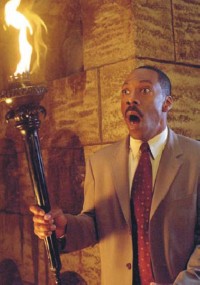 The
movie stars Eddie Murphy as Jim Evers, a workaholic realtor who is
headed for a weekend vacation with his family when they get side-tracked
by the chance to put a vast old mansion on the market. His wife, Sara
(Marsha Thomason), is his business partner who complains, as all movie
wives always complain, that her husband is spending too much time
at work. Their kids are Michael and Megan (Marc John Jefferies and
Aree Davis). Sara wants to handle it after the vacation, but Jim insists
- and they end up in a swampy countryside, welcomed to a cobweb-covered
chateau by Ramsley
The
movie stars Eddie Murphy as Jim Evers, a workaholic realtor who is
headed for a weekend vacation with his family when they get side-tracked
by the chance to put a vast old mansion on the market. His wife, Sara
(Marsha Thomason), is his business partner who complains, as all movie
wives always complain, that her husband is spending too much time
at work. Their kids are Michael and Megan (Marc John Jefferies and
Aree Davis). Sara wants to handle it after the vacation, but Jim insists
- and they end up in a swampy countryside, welcomed to a cobweb-covered
chateau by Ramsley
Evers (or more
accurately his wife, whose photo appears on their flyers) is invited
to visit the Gracey Mansion, isolated behind a forbidding iron gate
and surrounded by a jungle of sinister vegetation.
It's a triumph
of art direction, inspired by the Disney World attraction and by every
haunted house ever crept through by Bela Lugosi, Lon Chaney, Christopher
Lee, Peter Cushing, Abbott, Costello, et al. Doors bulge, curtains
sway, and there's a scenic graveyard behind the house, complete with
four marble busts that perform as a barbershop quartet.
The visitors are
greeted by the butler Ramsley (Terence Stamp) and as butlers of old
mansions go this one also has bulk both to size and voice. His voice
seems to come up from deep down in the basements.
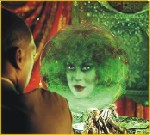 The
lord of the manor is a guy named Master Gracey (Nathaniel Parker),
who is obsessed with Sara Evers. Flashbacks show how Gracey in a past
life was in love with a young woman who looked exactly like Sara and
when they could not marry, they both killed themselves. So this makes
Gracey a ghost. Funny how the girl did not become a ghost along with
him to live(or unlive) together forever in the hereafter.
The
lord of the manor is a guy named Master Gracey (Nathaniel Parker),
who is obsessed with Sara Evers. Flashbacks show how Gracey in a past
life was in love with a young woman who looked exactly like Sara and
when they could not marry, they both killed themselves. So this makes
Gracey a ghost. Funny how the girl did not become a ghost along with
him to live(or unlive) together forever in the hereafter.
Yes you do get
the banging doors, swinging chandeliers and other ghostly effects
along with a bunch of zombies. The story mainly has a lot to do with
the characters and their lives. The scary bits include Madame Leota,
whose disembodied head floats in a crystal ball and offers timely
if disturbing advice.
The movie
isn't exactly scary, well, not for most adults anyway. It is a good
entertainer though, with Edie Murphy's wild screaming and a bit of
spooks popping out of nowhere. The kids will definitely love it.
Star
Wars: Knight of the Old Republic
Publisher:
LucasArts. Release Date: 11/18/2003 . Requirements: 128 MB RAM, 4X
CD-ROM, 32 MB VRAM, 4000 MB disk space, DirectX v9.0
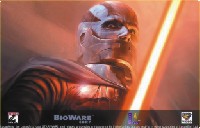 You
create a main character and then explore many different areas, interact
with many different characters, settle many different disputes, solve
many different puzzles, and engage in plenty of combat. Combat appears
to be in real time but actually uses a turn-based system "under
the hood" just like Neverwinter Nights, which means that your
character's statistics and attributes (and your strategy) make all
the difference, and your personal reflexes and hand-eye coordination
have no bearing on the outcome. Most importantly, Knights is very
different from your average RPG in that you'll always be an active
participant in the storyline, rather than a passive observer. You
don't just read, watch, and listen to a lot of text, cutscenes, and
dialogue; instead, your character is constantly invited and required
to make difficult decisions, and that's ultimately the most entertaining,
impressive, and rewarding aspect of the game. The interface has been
completely overhauled for the PC release of the game, and it works
exceptionally well by taking full advantage of the familiar mouse-and-keyboard
controls you're used to from other games. Additionally, it gives you
easy access to all your options, as well as your inventory, map, and
quest log, at all times.
You
create a main character and then explore many different areas, interact
with many different characters, settle many different disputes, solve
many different puzzles, and engage in plenty of combat. Combat appears
to be in real time but actually uses a turn-based system "under
the hood" just like Neverwinter Nights, which means that your
character's statistics and attributes (and your strategy) make all
the difference, and your personal reflexes and hand-eye coordination
have no bearing on the outcome. Most importantly, Knights is very
different from your average RPG in that you'll always be an active
participant in the storyline, rather than a passive observer. You
don't just read, watch, and listen to a lot of text, cutscenes, and
dialogue; instead, your character is constantly invited and required
to make difficult decisions, and that's ultimately the most entertaining,
impressive, and rewarding aspect of the game. The interface has been
completely overhauled for the PC release of the game, and it works
exceptionally well by taking full advantage of the familiar mouse-and-keyboard
controls you're used to from other games. Additionally, it gives you
easy access to all your options, as well as your inventory, map, and
quest log, at all times.
Knights of the
Old Republic actually takes place thousands of years before Star Wars
Episode I, though you'll still see many of the same sorts of alien
creatures and technology in the game that you probably associate with
Star Wars. The story begins in the midst of a power struggle between
the Republic and the Sith, an evil Imperial power that's encroaching
on Republic space. Your character seems to be just another Republic
trooper, and, at the beginning of the game, you manage to avoid certain
death as your spaceship is attacked and destroyed. Your escape pod
lands on a world that's been put under quarantine by the Sith, so
your first order of business is to find a means of escape. You also
need to find out what happened to Bastila, a gifted young Jedi who
is key to the Republic's war efforts and who also managed to flee
your doomed ship. Later, you'll be charged with uncovering the secrets
of an ancient relic, called the star forge, apparently the key to
the Sith's seemingly limitless supply of weaponry.
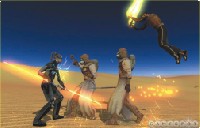 Your
main character starts off as a male or female soldier, scout, or scoundrel.
The soldier is straightforward but very strong, and he or she begins
with proficiencies in various types of weapons and armor and gains
the most vitality points per experience level. The scoundrel is physically
the weakest class but can disappear from sight by using special cloaking
devices; after "cloaking" he or she can inflict great damage
to a foe if that foe is caught unaware of the impending attack. The
scoundrel is also best suited to talking his or her way out of situations
where the other character classes might have to resort to violence.
Your choice of gender also has a bearing on the outcomes of some situations.
Your
main character starts off as a male or female soldier, scout, or scoundrel.
The soldier is straightforward but very strong, and he or she begins
with proficiencies in various types of weapons and armor and gains
the most vitality points per experience level. The scoundrel is physically
the weakest class but can disappear from sight by using special cloaking
devices; after "cloaking" he or she can inflict great damage
to a foe if that foe is caught unaware of the impending attack. The
scoundrel is also best suited to talking his or her way out of situations
where the other character classes might have to resort to violence.
Your choice of gender also has a bearing on the outcomes of some situations.
It's not spoiling
anything to point out that you eventually gain access to Jedi powers.
In turn, there are three different Jedi classes available, which emphasize
either the Jedi's prowess with a lightsaber, his or her Force powers,
or a balance of the two. Force powers are basically like magic spells,
allowing you to do such things as stun opponents, knock them down,
and choke them. In addition, you can heal yourself and use the Force
to persuade characters to see things your way (the option will come
up at times during dialogue). Some powers are inherently light-inclined,
while others are dark-inclined, and though Jedi characters may gain
access to any Force power as they gain experience levels, powers that
match a Jedi's moral alignment can be used at a lower cost in Force
points (which steadily recharge, thus allowing you to use your powers
continuously).
The game does
a fine job of letting you customize your character and his or her
companions. Nine main different characters may join you over the course
of the adventure, and you'll be able to travel with up to two of them
at a time. They mostly do a good job keeping pace, but in some of
the more mazelike environments, they're liable to lag behind, which
can be slightly annoying. Most every character has an interesting
story to tell that unfolds as you converse with him, her, or it over
the course of the game, though some are developed better than others.
The most entertaining of the bunch is probably HK-47, who's like a
homicidal and slightly insubordinate C-3PO. As you and the others
gain levels, you develop your abilities by choosing from a wide variety
of skills (repair, stealth, persuasion, and so on) and combat feats
(critical strike, two-weapon fighting, toughness, and so on).
Combat looks dynamic,
and, at a glance, you could mistake Knights of the Old Republic for
an action game. You'll see characters firing away with their blasters,
while those armed with melee weapons, like lightsabers, will perform
a variety of close-combat moves. Characters dueling with such weapons
will block and feint while looking for openings in their opponents'
defenses. It's all clearly inspired by the dramatic lightsaber battle
at the end of Episode I and also resembles the outstanding lightsaber
battles in the recent Jedi Academy and last year's Jedi Knight II.
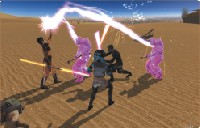 Your
characters will automatically attack any foes nearby until either
you or they are all dead, so, in some cases, you end up simply watching
the fight as it unfolds. You'll only need to intervene to use healing
kits, stimulants that boost your combat abilities, Force powers, and
the like. You may also intervene, if necessary, to prioritize targets.
You can pause the action at any time and can easily queue up specific
orders for all your characters, but you can usually get away with
just looking after your main character and will rarely need to micromanage
things (your party members will lag behind once in a while, as you're
running around, but it's not a big deal). Generally, the combat is
exciting to watch and is paced nice and fast. You needn't worry if
one of your characters falls in battle, as he or she will simply get
up once the fighting is over--though you're tossed back to the title
screen if your entire party goes down.
Your
characters will automatically attack any foes nearby until either
you or they are all dead, so, in some cases, you end up simply watching
the fight as it unfolds. You'll only need to intervene to use healing
kits, stimulants that boost your combat abilities, Force powers, and
the like. You may also intervene, if necessary, to prioritize targets.
You can pause the action at any time and can easily queue up specific
orders for all your characters, but you can usually get away with
just looking after your main character and will rarely need to micromanage
things (your party members will lag behind once in a while, as you're
running around, but it's not a big deal). Generally, the combat is
exciting to watch and is paced nice and fast. You needn't worry if
one of your characters falls in battle, as he or she will simply get
up once the fighting is over--though you're tossed back to the title
screen if your entire party goes down.
The combat and
the dialogue are the two main elements of Knights of the Old Republic.
Other than these activities, you'll find yourself running from place
to place, but you'll have little interaction with the environment
other than being able to open footlockers and other objects that contain
goodies. You can sometimes hack into certain computer systems, but
this is all done in text and isn't very interesting. Loading times
between areas can feel a little disruptive, especially when you have
to backtrack. Fortunately, there's an option to instantly return to
your hideout or ship if you're not in a dangerous area. Some of the
environments are pretty big but most aren't, and a mapping system
clearly shows where you can and can't go and what the points of interest
are in each area. There's also a very clear record of all the quests
you have pending (and all the quests you've completed). As such, you'll
probably never get lost in the game, though, at the same time, you
might feel a bit confined by where you can and can't go. Fortunately,
the game opens up later on, thus allowing you to freely travel between
planets to accomplish numerous tasks in whichever order you please.
